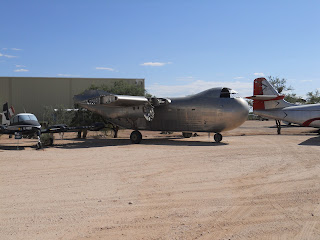David writes...
Last weekend, I was telling Frank that I was headed to Tucson, Arizona this week for work. Frank remarked that I should visit the Pima Air & Space Museum, located just south of town, adjacent to Davis-Monthan Air Force Base. He said Pima was "The IRM of air museums!" Boy, was Frank right.
The museum consists of several hundred aircraft, of all types, both civil and military. Some aircraft are displayed indoors, in one of five hangars used for display. There are two additional hangers used as shop space for restoration work. Pima has a large and historically significant collection of aircraft, everything from a replica Wright Flyer, to a SR-71 Blackbird spy plane. Let's look at a few examples:
For IRM member Bill Wulfert, we have this former TWA Lockheed Constellation. The plane was built for the Army Air Force, but declared surplus after World War II, and sold to TWA, which used it until 1961. Beside it sits a former TWA tug and a luggage cart and tug.
IRM has the streetcar loop to provide transportation around the museum campus. Pima uses trams that look like they were converted from old bread trucks. The trams make a loop of the property and provide a way to see the outdoor collection without baking in the sun. Here we see the tram parked in front of a NASA Boeing KC-135, named the "Vomit Comet." This was the plane the flew parabolic arcs to train astronauts how to work in a weightless environment, 30 seconds at a time.
During WWII, aircraft aluminum was in short supply. As one potential solution, the Budd Company (Yes, that Budd Company) of Philadelphia designed the Budd RB Conestoga transport aircraft. The aircraft was made almost entirely of stainless steel with fabric covered control surfaces. Powered by the same Pratt & Whitney engines used in the C-47 Skytrain (The military version of the DC-3), the aircraft utilized Budd's patented shot welding technology, just like on the Nebraska Zephyr. The aircraft proved to be heavier than a C-47, and as a result the performance was sluggish. As one test pilot pointed out, it handled as one would expect an aircraft built by a railcar company would handle. Only 17 were built before the project was cancelled. The cargo airline Flying Tigers flew them. This is the sole surviving example, awaiting restoration.
Here we see a closeup of the Conestoga's skin, showing the shot welded sides, just like the Zephyr!
Much like the crews that polished the Nebraska Zephyr at IRM last year, the group at Pima is in the process of polishing a bomber. Back in the restoration shop, crews are polishing a Boeing B-50 bomber. The B-50 was the postwar improvement of the B-29. This one has little jet engines added in pylons on the wings for additional takeoff thrust.
Here is an example of a Boeing B-52 Superfortress. Many are still in service with the Air Force. Pima has at least TWO on display.
A very nice example of a B-29 Superfortress was inside one of the buildings, as was this example of a Curtiss C-46 Commando.
With five display hangars, two restoration hangars and many airplanes stores outside, staff at Pima make use of a small fleet of golf carts, just like at IRM.
Needless to say, if you are in the Tucson area, you need to visit the Pima Air & Space Museum.










2 comments:
The Lockheed Constellation is as iconic to my thinking as a Alco PA. Your comparisons between a rail museum and a air museum were very interesting and apt, which surprised me. The common ground of good museums is often overlooked. Thanks for posting this.
Bruce,
I am glad you liked it. Seeing how other museums approach similar problems and obstacles is a good exercise. Of course, most air museums do not operate, which is a plus for them. The arid climate is helpful to protect the aluminum aircraft, but isn't so nice on glass, plexiglass, cockpit interiors, upholstery and wood.
David
Post a Comment